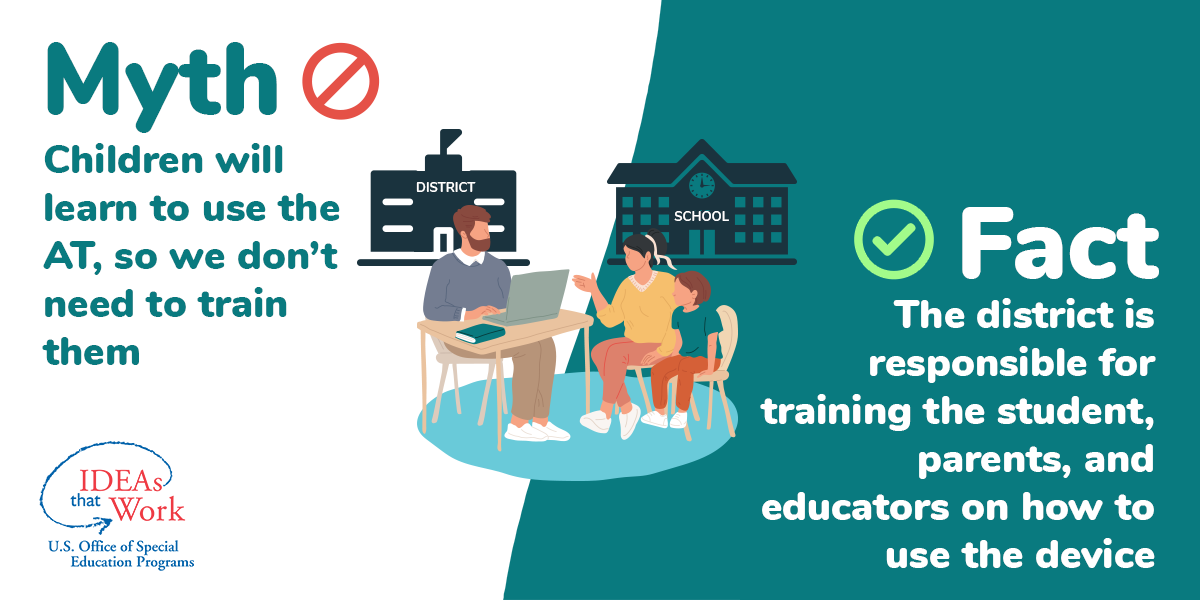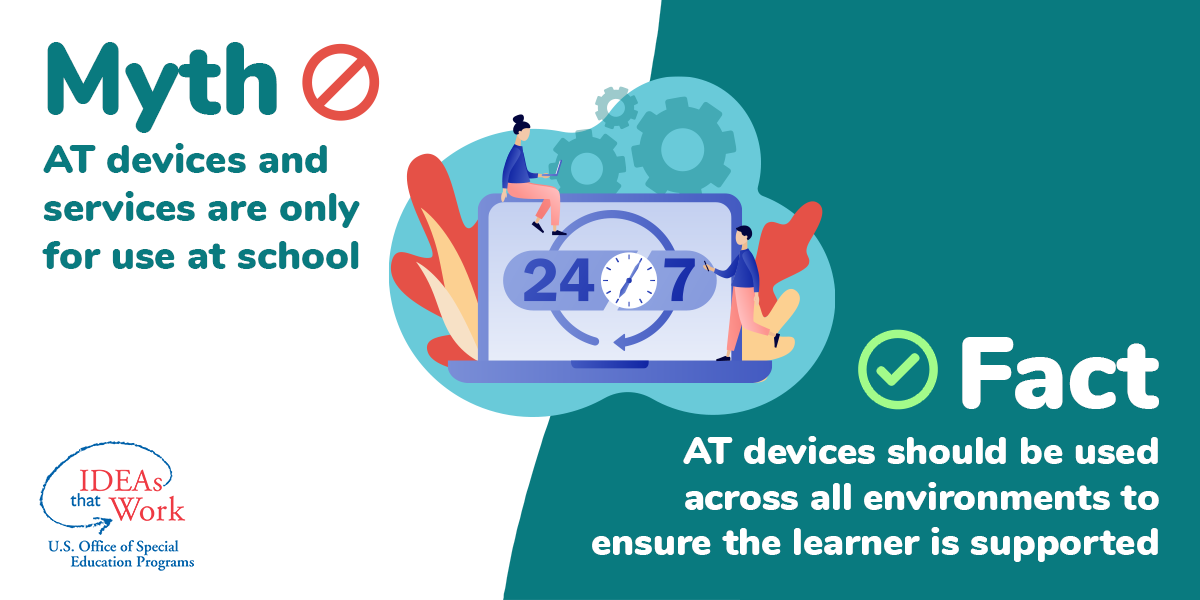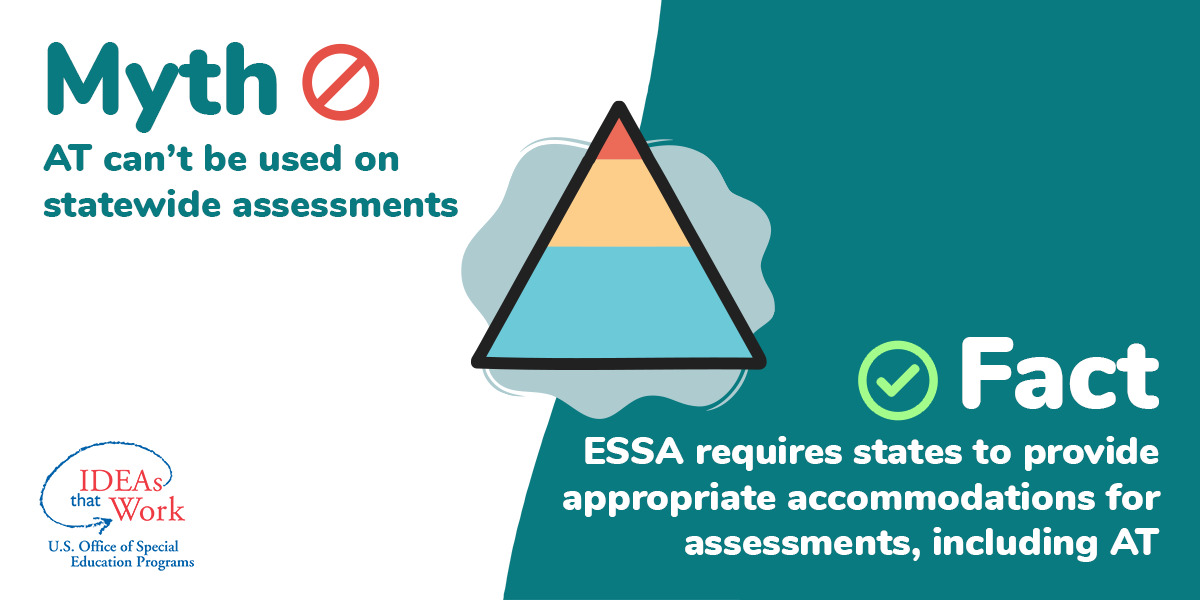Sections of the IEP
Overview:
If AT has been identified for a student, it must be indicated in Section 2: Special Instructional Factors of the Ohio IEP form (PR-07). In addition, details of the Assistive Technology Device(s) and/or Service(s) must be documented in the IEP. The AT may be included and referenced in more than one section of the student’s IEP. However, It Is helpful to always document In the Assistive Technology subsection in Section 7: Descriptions(s) of Specially Designed Services because the team will be able to locate the information easily.
Questions that a team might consider when documenting AT in the IEP include the following:
- Is the AT to be used as an allowable accommodation for state and district testing?
- Does the student need AT when transported to and from school?
- Is the student visually impaired?
- Do others need to be trained for the AT to be successful for the student?
- Is the AT needed for employment, independent living, or postsecondary activities?
The IEP document should clearly reflect the AT features needed, describe how it will be used, and the services/supports required. The following will provide information about how each section may be populated if AT is addressed within that section.
AT may be included in the “Other Information” box or in the “Amendments” text field.
- Other Information – Some AT information may be included in this section as determined by the LEA.
- Amendments – The Amendments box could be used if at some point before the annual IEP meeting it is determined through the collection and analysis of data that the conditions or services for use of AT by a student have changed or if the AT is no longer needed by the student. The amendment section requires documentation to indicate what section is being amended, what changes have been agreed upon by the families and LEA, the date of the amendment, the participants, roles and initials of those agreeing to the changes. Any of the sections where AT might be referenced could be included in the amendments section.
This section typically addresses the student’s future vision and goals as seen through the family’s and student’s perspective. These goals could include the need for or use of AT if identified by the student or family.
In the context of IEP development, review, or revision, consideration of AT is intended to be a collaborative process in which team members decide whether are needed for the student to access the general education curriculum or achieve IEP goals. It requires that the IEP team includes (or has access to) someone who has knowledge about AT or who can guide the team in considering AT in the context of what they know about the student. Team members who are considering AT should examine available data and observations about the student. Team members may consider any of the following.
Will the AT help the student:
- Receive instruction within the least restrictive environment (LRE)?
- Meaningfully participate in the general curriculum (reading, writing, math, science, etc.)?
- Participate in extracurricular and nonacademic activities (music, art, sports, functional activities such as orientation and mobility, independent living skills, etc.)?
- Safely travel to access school, school-sponsored community activities, and extracurricular opportunities?
- Access textbooks, and other print and educational materials?
- Access auditory and visual information?
- Enhance communication and social interactions?
- Participate in readiness activities for postsecondary training and education, competitive integrated employment, and independent living?
- Participate in state and local assessments?
NOTE: This should not be considered a comprehensive list.
After the student’s needs for AT have been considered, the IEP team must answer the following question within the Special Instructional Factors section. “Does the child need assistive technology devices and/or services?” (Yes/No)
- Check “No” if:
- the child is able to engage in school and life tasks efficiently, effectively, and independently without AT supports.
- Check “Yes” if:
- the team determines more information is needed and the AT assessment process should be initiated.
- the child’s current AT is not effective.
- the child’s current AT is effective and should be continued.
For more information, see the AT Resource Guide Section 2: Assistive Technology Consideration in the IEP. For support with AT and AEM decision making, please see the AT Decision Making Tool.
This section is a place to summarize the student’s strengths and needs. It typically includes relevant medical history, safety information, interests, background information, present levels of academic achievement and functional performance that would not be included in the goals to be addressed, and, as appropriate, performance on state and district assessments. This is also the area of the IEP to document the parents’ educational concerns. Additionally, for students of preschool age, summarize the student’s developmental strengths and needs in all relevant areas. AT documentation in this area might include information about prior AT assessments with a summary of results, past use of AT and the outcomes, and descriptions of current AT systems and how they impact the student’s progress in the general education curriculum.
AT information in the Profile Section might include the following:
- Description of AT devices (including family-owned devices) the student is using including how the AT devices are being used and incorporated into the school curriculum and environment.
- Relevant AT history including previous use of and/or acquisition of an AT device or service.
In Ohio, students with disabilities who are age 14 – or earlier if the IEP team determines it is appropriate – formally enter the secondary transition process. At this time, the IEP must include measurable postsecondary goals based on age-appropriate transition assessment (AATA) related to education and training, competitive integrated employment and, if data supports a need, independent living. The IEP must also include transition services, including courses of study, needed to assist the student in reaching those goals.
The student’s use of or need for AT may be documented directly within the following key elements of the transition plan:
- AATA – Information gathered and documented during the AATA should include any AT that the student is currently using or may need in order to move toward achieving the postsecondary goals.
- Transition Service/Activities – If it is determined during the AATA process that the student may need AT the IEP team should consider whether a transition service/activity should be developed to address the need. For example, an occupational therapist may train the student how to use the AT during a work-based learning experience.
- Measurable Postsecondary Goals: If the student uses AT to achieve postsecondary goals, the IEP team may consider including a reference to the AT within the goal(s).
AT information could be included in the following sections of Measurable Annual Goals:
- Present Level of Academic Achievement and Functional Performance
How AT is being used, a description of the AT services needed, and the need for further AT assessment would be included in this section. When indicating use of current or new AT, make sure present levels include measurable baseline data upon which a goal can be written.
- Measurable Annual Goals
There is a direct correlation between the student’s needs as identified in the data and required AT supports and services. The goals and objectives are defined by the needs identified in the Present Level of Academic Achievement and Functional Performance.
Measurable annual goals are directed toward what can be taught to the student using specially designed instruction (such as communication of 3+ word sentences, writing a paragraph with topic sentence, three details and a conclusion, etc.).
- The condition of the goal could include AT (such as using a communication device/verbalizations or sign language, using word prediction or speech recognition to produce written work, etc.).
- Goals related to learning the use/operation/integration of an AT tool in the curriculum may be needed.
- Any mention of AT in the goals should be reflected in the measurable objectives/benchmarks.
In this section, the IEP team identifies 1) AT device features and 2) services related to the needs of the student, providing access to the general curriculum and functional needs. AT devices and services can be documented in many areas within Description(s) of Specially Designed Services depending on the identified service, features, and/or environment and purpose of use. It is not necessary or recommended to document AT devices and services in all sections below.
A description of the AT device(s) and/or AT services that the student needs should be documented in Section 7 of the IEP in the AT subsection. AT device(s) are identified by describing the features needed by the student rather than naming the specific device. Naming the features may assist in identifying a device with equivalent features should a substitute device be necessary. Additionally, it may help a service provider understand which features are necessary and must be made available for the student as many devices contain a large range of features. AT services is any service that directly assists a student with a disability in the selection, acquisition, or use of an assistive technology device. Services can be documented in the AT, Related Services and Support for School Personnel subsections.
The following outlines the content that may appear in the various subsections regarding AT device descriptions and services.
Assistive Technology (AT) Subsection
The need to assess a student for AT devices and services or to document the ongoing use of AT is most frequently referenced in this subsection of the IEP. However, when documenting the description of AT tool(s) and features in this section, it is not necessary to indicate who, where, and when because AT tool(s) should be available when needed by the student. The following are recommendations for populating the various text fields. Note that when documenting AT services in this section the who, where, and when are required.
- Type of Service – AT device features and services related to the unique needs of the student, providing the student access to the general curriculum, and supporting functional needs.
- Goal Addressed - Identify the goal(s) that are associated with the AT device. Goals may be related to skills or access to the general curriculum or functional needs.
- Provider Title – Indicate who will be delivering the services (e.g., intervention specialist, general education teacher, SLP, OT, etc.).
- Location of Service – Indicate where the service will be delivered.
- Beginning date of service or the start of the IEP and end date of service or the end date of the IEP. An AT assessment would likely have a beginning and end date different from the IEP.
- Amount of Time – Indicate the number of minutes/hours needed to provide the specially designed instruction related to the goal(s) identified.
- Frequency – Indicates how frequently the service will be provided.

AEM Tie-In:
Services may be required to support a child's use of accessible formats to effectively participate in the general education curriculum as specified in the IEP.
Accommodations Subsection
AT is a tool, device, or something tangible that can also be documented in the accommodations subsection, when appropriate. Accommodations change how the student accesses and demonstrates learning. However, accommodations can also include nontangible such as extended time, small group, separate setting. If the accommodations subsection of the IEP is used to document AT, the team should be aware that the conditions for and extent of are important criteria to include for accommodations as they specify the parameters of use by the student. The documentation location for AT or an accommodation depends on how and for what purpose the student is using the tool.
If AT is also included in the accommodations subsection, the following are recommended:
- If documenting the description of AT tool(s) and features in this section, it is not necessary to indicate the who, where, and when because AT tool(s) should be available at all times.
- Begin date of the service or IEP.
- End date of the service or IEP.
Related Services Subsection
Some students may need related services to support their use of AT. If determined by the IEP team as needed, those services could be documented in this subsection. The following are recommendations for populating the various text fields.
- Document related services provided to support the AT.
- Identify the goal that is associated with the AT device and specific related services.
- Provider – Indicate who will be delivering the services (e.g., SLP, OT, PT).
- Location – Indicate where the related services will be delivered.
- Begin date of the service or IEP.
- End date of the service or IEP.
- Amount of Time – Indicate the number of minutes/hours needed to provide the related services for the goal identified.
- Frequency – Indicates how frequently the service will be provided.
Support for School Personnel Subsection
Adults will need training/consultation to support the student’s use of the AT, possibly including setup/programming or other technical aspects of the device. These needs can be documented in the Support for School Personnel subsection. The following are recommendations for populating the various text fields.
- Describe the training/consultation that will be provided to the school team including who will provide and who will receive the training/consultation.
- Begin: document the beginning date of the IEP or training/consultation service.
- End: document the end date of the IEP or when the training/consultation will be complete.
The Transportation section of the IEP addresses the needs the student might have related to special transportation due to a disability. AT may be needed to provide safe travel in order to access school, school-sponsored community activities, and extracurricular opportunities. AT would be addressed in this area if the student has needs for a wheelchair lift, harnessing system, securement system, or other specialized AT devices that could impact safety, comfort, or other identified needs of the student during transportation. This section contains prepopulated choices but also provides an “other” checkbox and text field to provide documentation of specific supports not included in the prepopulated choices.
The Nonacademic and Extracurricular Activities section of the IEP addresses supplementary aids and services necessary for a student to participate in athletics, clubs, special interest groups, recreational activities, counseling, and health services. If a student needs AT in order to participate in nonacademic and extracurricular activities meaningfully or successfully, a description of the AT features, purpose, and environment should be included in the description for opportunities to participate.

AEM Tie-In:
If the IEP Team determines the use of one or more accessible formats is needed to provide FAPE to the child with a disability, the child's use of the accessible format(s) must be supported across all environments.
All students are required to participate in state- and district wide testing at their appropriate grade level. The IEP team must determine how students with disabilities will participate in state- and district wide assessments. State eligibility guidelines for participation in the Alternate Assessment for Students with the Most Significant Cognitive Disabilities are available on the Department of Education and Workforce page called “Ohio’s Alternate Assessment for Students with the Most Significant Cognitive Disabilities (AASCD)”.
When a student uses AT in the classroom to access the general education curriculum, it is assumed they will need the same type of AT features for statewide and district testing. The Ohio Department of Education and Workforce (ODEW) encourages an iterative approach to accessibility decisions. As students’ needs evolve, decisions should be reevaluated to ensure that appropriate accessibility features are provided. Within Ohio’s online assessments, universal tools are always available. Designated supports and accommodations can be made available based upon the student’s needs. These features will need to be documented in detail in the student’s IEP in sections 7 and 12. To learn more about the universal tools, designated supports, and the eligible accommodations for Ohio’s State Tests visit Accessibility for Ohio’s Students. AT considered for use during testing cannot change the construct of what is being measured by the test and must also be identified as an allowable accommodation in the Ohio Accessibility Manual.
Supports provided in the statewide tests can be explored by visiting Ohio’s Assessment System. From the State Test Portal, test coordinators, educators, and families can explore resources and practice test materials. Additionally, braille state practice tests can be accessed through the OCALI lending library. District assessments may have different allowable accommodations than statewide assessments. Assessments developed by vendors other than the Ohio Department of Education and Workforce should refer to the vendors' accessibility manuals.
An accommodation should never be introduced to the student during testing. Teachers should expose students to online test items, using accommodations, in the Student Practice Site.

AEM Tie-In:
Appropriate accommodations for State assessments include providing the assessment in an accessible format for a child with a disability who requires it.
The Children With Visual Impairments section is completed if the student has an eligible visual impairment as defined by the IDEA. The student may be qualified for special education services under any disability category but still have an eligible visual impairment. This section includes services needed for a student with visual impairments, including accessible formats such as audio, braille, large print, tactile graphics, and digital text conforming with accessibility standards. Although AT is not specifically mentioned in this section of the IEP, the determination to use accessible formats of instructional media may require the use of AT for access. In that case, the AT should be documented in other sections of the IEP as appropriate.
